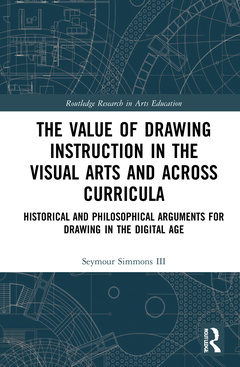The Value of Drawing Instruction in the Visual Arts and Across Curricula Historical and Philosophical Arguments for Drawing in the Digital Age Routledge Research in Arts Education Series
Auteur : Simmons III Seymour

By applying philosophical and historical perspectives to drawing instruction, this volume demonstrates how diverse teaching methods contribute to cognitive and holistic development applicable within and beyond the visual arts.
Offering a new perspective on the art and science of drawing, this text reveals the often-unrecognized benefits that drawing can have on the human mind, and thus argues for the importance of drawing instruction despite, and even due to contemporary digitalization. Given the predominance of visual information and digital media, visual thinking in and through drawing may be an essential skill for the future. As such, the book counters recent declines in drawing instruction to propose five Paradigms for teaching drawing ? as design, as seeing, as experience and experiment, as expression, and as a visual language ? with exemplary curricula for pre-K12 art and general education, pre-professional programs across the visual arts, and continuing education. With the aid of instructional examples, this volume dispels the misconception of drawing as a talent reserved for the artistically gifted and posits it as a teachable skill that can be learned by all.
This text will be of primary interest to researchers, scholars, and doctoral students with interests in drawing theory and practice, cognition in the arts, positive psychology, creativity theory, as well as the philosophy and history of arts education. Aligning with contemporary trends such as Design Thinking, STEAM, and Graphicacy, the text will also have appeal to visual arts educators at all levels, and other educators involved in arts integration.
List of Figures
Acknowledgments
Preface: Toward a Renaissance in Drawing Education
Chapter 1: Introduction: Making the Case for Learning to Draw in Changing Times
Chapter 2: Beginnings: Drawing as an Innate Human Capacity and a Matter of the Mind
Chapter 3: What’s in a Name? The Uses of Philosophy in Drawing Education
Chapter 4: Drawing by Design: Connecting Drawing and Design through Mathematics
Chapter 5: Drawing as Seeing: Observational Drawing in Art, Science, and Medicine
Chapter 6: Drawing as Experience and Experiment: Creativity in Art and Experimental Science
Chapter 7: Drawing as Expression: Self-Knowledge, Healing, and Societal Concerns
Chapter 8: Languages of Drawing: Semiotics and the Search for Fundamentals
Chapter 9: Toward a Comprehensive 21st Century Philosophy of Drawing Education
References
Index
Seymour SimmonsIII is a Professor of Fine Arts Emeritus at Winthrop University, USA.
Date de parution : 09-2022
15.2x22.9 cm
Date de parution : 03-2021
15.2x22.9 cm
Thèmes de The Value of Drawing Instruction in the Visual Arts and... :
Mots-clés :
Drawing education; cognition; creativity; arts education; Seymour Simmons; philosophy of education; visual arts education; drawing instruction; teacher education; drawing theory; multiple intelligences; slow looking; creativity theory; positive psychology; pre-K-12 education; HMS Victory; continuing education; Young Men; Visual arts; Rembrandt; Rembrandt Van Rijn; Discipline Based Art Education; Visual language; National Art Education Association; Standard IQ Test; Drawing Back; National Visual Arts Standards; Studio Habit; Viktor Lowenfeld; Stem Subject; RMN Grand Palais; Pennsylvania State University; William Kentridge; Vande Zande; Baccio Bandinelli; College Art Programs; Observational Drawing; Mass Art; Zaha Hadid; Bodily Kinesthetic Intelligence; Steam; Existential Intelligence



